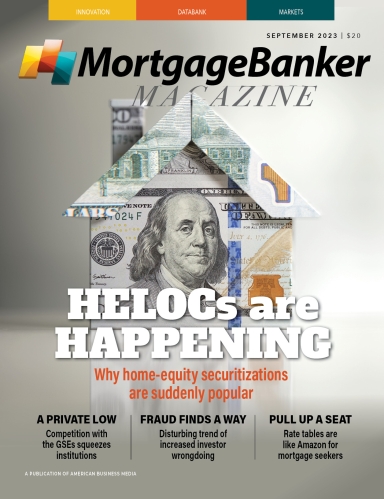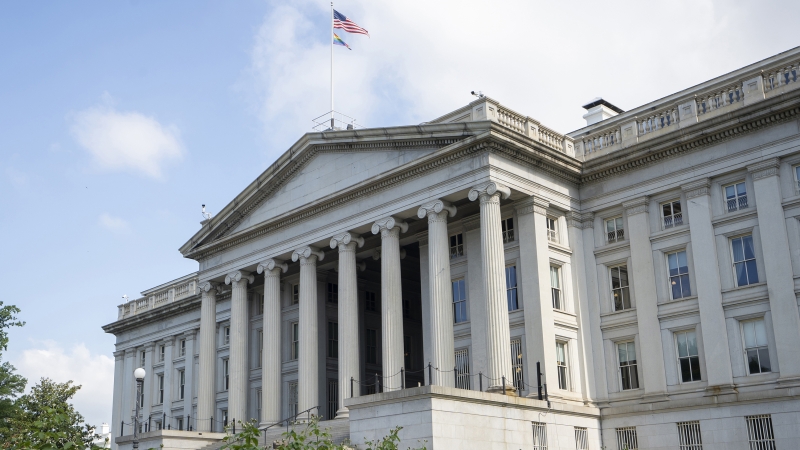Even so, regional banking turmoil has disrupted securitization markets across the entire economy. Last year, skittishness on account of rising interest rates forced Schiano to hit pause on expansion. “Last summer, I actually thought we were gonna grow so fast it would’ve put the company in a dangerous position. So, we slowed back growth and now we’re growing again because we think the market is more stable today than it was last year,” he says.
Just a couple years ago, home equity origination volume was much lower, and most of the loans that Figure originated were sold to credit unions. “There wasn’t as much of a need to have and to demonstrate that you could get a rating because there were investors who were comfortable taking the loans without necessarily having a rating,” Frommer says. That’s all changed, with consumer demand rising and rising interest from investors with nowhere to park their money in traditional RMBS now that first-purchase originations are at historic lows.
Though unrated home equity securities aren’t necessarily deficient from a credit perspective, ratings indicate a higher degree of due diligence has been performed on the underlying loan collateral, which is necessary to attract a larger and more diverse pool of institutional investors.
“Both in time and in what the loans actually look like,” explains Kahan of KBRA, “there is a need for education out there for people to kind of dust off their old data sets and understand the historical performance and understand the difference in the products.” He says that, despite uncertainty in capital markets, the size of the players who have begun originating to securitize is indicative of the secondary market’s potential.
FirstKey Mortgage, Towd Point Mortgage Trust, JP Morgan, Rocket Mortgage, and Freedom Mortgage, among others, have all achieved or are in the process of achieving rated transactions for second-lien securities.
“These are all issuers who have accessed capital markets through ratings in the past,” says Kahan. “These are larger institutions that I expect are looking to do less of a one-off trade securitization and more of a programmatic securitization where it might make more sense to do the background legwork, to get ratings, to build an investor space because the expectation would be that they’re going to come with more transactions in the future.”
More lender competition means ratings are becoming even more important for delivering consistency and stability to the secondary market. What’s more, ongoing liquidity constraints with depository institutions means Frommer’s seeing particular demand from credit funds and insurance companies.
“There was a gap for a very long period of time,” she says, “in terms of investors and rating agencies really understanding the product, which is what you need to do to get the product from origination to having a successful securitization.”
Many large institutional investors, like insurance companies, require ratings as part of their investing mandate. They won’t play without one.
“Having a rating is very helpful,” Frommer continues. “It opens up the universe of people who can buy the product.”
New Loan Attributes
The universe of investors, however, wants to know more about the universe of borrowers who are tapping home equity in place of cash-out refinances. Kahan remembers how, pre-crisis, second-liens and HELOCs were originated to the same standards (or lack thereof) as the first-lien market. Alternative documentation and sloppy origination came back to bite borrowers, lenders, and investors.
To date, KBRA has rated transactions for Spring EQ, Towd Point, Rocket, and JP Morgan. In Kahan’s perspective, the methodology for rating second-lien securities isn’t that different from what they use on the first-purchase side: operational reviews of origination and aggregation models; third-party due diligence to ensure underwriting and regulatory compliance; and, modeling of collateral to determine loan samples’ default and severity risk.
“For the most part,” Kahan says, “we’re talking about prime credit borrowers, generally low-CLTV loans, and generally fully-documented income. From an underwriting perspective, there’s not much adaptation that needs to be made because we’re generally talking about prime, full-doc loans.”
Instead, where rating agencies and due diligence firms are having to catch up to speed is in matching the default and severity risk with loan attributes that differ from the pre-crisis era. Notably, combined loan-to-value ratios (CLTVs) are 20 points lower for home equity originations today than they were in 2006. Weighted average FICO scores are 50 points higher.
Changes in product features and loan attributes directly affect credit performance, Kahan says. “Those are the first questions that we get from the investors: How is this different? How do we think about credit enhancement for these loans in light of what ultimately was not very good performance of seconds and HELOCs in the crisis period?”
Part-and-parcel of why loan attributes are changing is an evolving “use-case,” or purpose for home equity loans, both for borrowers and lenders. This has forced rating agencies and due diligence firms to view the second-liens and HELOCs being originated as almost entirely new products, from a liquidity perspective. This is particularly true for HELOCs.
“HELOCs, traditionally,” says DBRS’s Koudinov, “were a product more available to prime and near-prime borrowers. It was extended by banks and credit unions, not so much for the purposes of securitization, per se, but really for the purposes of portfolio retention.”
Pre-crisis, closed-end home equity loans would be fully drawn at origination, while HELOCs were treated more like rainy-day funds to manage cash flows, and drawn down as needed. Depositories had ready access to capital, and borrowers weren’t using HELOCs to capture equity immediately.
Now, HELOCs offered by nonbank lenders like Spring EQ, Achieve, or Figure are anywhere from 80 – 100% drawn on origination, and these lenders are striving to securitize. “They sort of offer the HELOC product as a mover option in addition to a personal loan, or perhaps in some cases even trade that alternative to a personal loan,” explains Koudinov.
Adapting to Automation
Changes in loan attributes and loan purpose are largely being driven by lenders who are focused on speed to fund, or closing the time it takes to go from application to approval.
“We’re trying to fundamentally change the way people use home equity to help them manage their finances more broadly than how they might have used a cash-out refi before,” says Frommer. In April, Figure announced its first rated HELOC securitization, comprised of Class A and B notes, rated AAA and A by DBRS Morningstar, respectively.
A question the rating agencies are trying to answer is whether, in the spirit of efficiency, any due diligence has been lost on the origination side. Figure, for example, leverages automated valuation models (AVMs) to fund HELOCs in just five days.
“This is different than what we saw for most of the second lien and HELOC lending in the crisis,” says Kahan, “where they were mostly simultaneous seconds. They were purchase loans. This was down payment assistance. These were borrowers that didn’t have the equity at the time of purchase.”
The biggest difference that analysts at DBRS have seen from pre-crisis home equity lending to today is also in underwriting. While depositories tend to underwrite home equity loans very conservatively because they hold them as portfolio products, it takes time to understand how AVMs and alternative sources for documenting income and employment affect creditworthiness.
“With efficiency and automated processes and underwriting, there is always a compromise between time and thoroughness,” says Koudinov. “We have an operational risk review process that covers origination platforms and servicing platforms through which we seek to understand not so much the data that’s provided to us, but really the loan manufacturing process or HELOC manufacturing process from A to Z.”
It’s a shared responsibility between rating agencies and due diligence firms, says KBRA’s Kahan. Making sure they understand these processes benefits all parties involved, from the borrower to the institutional investor.
“When you have an automated origination file, what does that review look like? What exactly is that third party firm looking at in the loan file? That’s a piece of the adaptation that, frankly, is still going on. How exactly do we get comfortable? If you see a loan from an originator who’s performing this automated process and you see one from a more traditional lender, then can you put these on level footing? Do you get the same level of comfort?”
Operating At Scale
With consumer and investor demand increasing, scaling due-diligence capabilities will be a critical area to address if the home equity securitization market is to expand. First-lien mortgage securities have larger collateral pools and smaller loan populations than home equity-backed securities, which makes loan-level due diligence and full appraisals more economical.
The average loan population for the 14 securitizations reviewed for this article was 3,379 loans, with an average collateral pool of $199,029,003. In 2022, the average loan count for first-lien securities was 822 loans, with an average deal size of $429,792,897.
Across the industry, “sampling” presents itself as a clear solution, which involves reviewing portions of the securitized pool and imputing that error rate into the unsampled portion. However, sampling isn’t common in first-lien securitization, and is slow to be adopted for second-lien securitization.
Despite slow adoption, sampling is an efficient and viable way to scale due-diligence across the larger loan pools of second-lien securities. “That can come with its own additional expected losses or additional credit enhancement from a rating agency standpoint, but the issuers would think about what their trade-off is there,” Kahan explains.
Sampling by third-party due diligence firms can happen in a variety of ways, says Justin Becker, assistant vice president at DBRS Morningstar. “You have certain originators who choose to do due diligence on a rolling basis, monthly, quarterly. They’ll sample their population and have that as part of their quality control.”
In the case of Figure’s first rated transaction from April, which DBRS rated, “the prospective loans for the securitization were sampled randomly at a percentage that met our criteria and we disclose in our rating reports,” Becker explains. “It’s not to say that those are the only ones they had reviewed by the third-party due diligence firms, it’s just the only ones we were presented with.”
At the end of the day, while lenders want speed, the rating agencies are focused on getting their credit-risk assessments right. So far, they are.
“Thus far,” says Koudinov, “even with expansion, we have not seen any signs of weakness in the collateral pools that we’ve reviewed. I think the transactions we’ve rated had fairly consistent collateral attributes, which is a good sign.”









